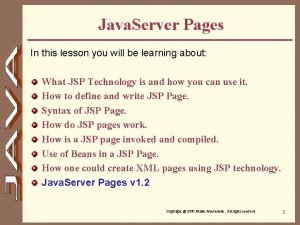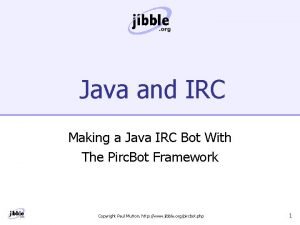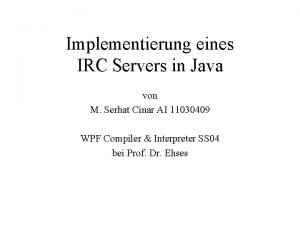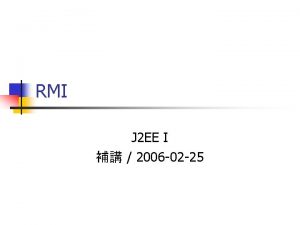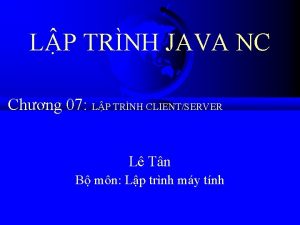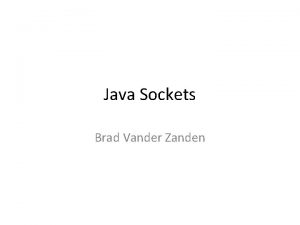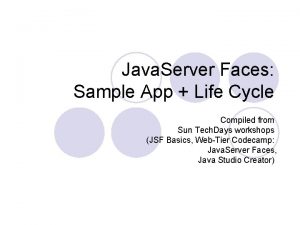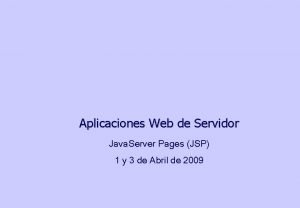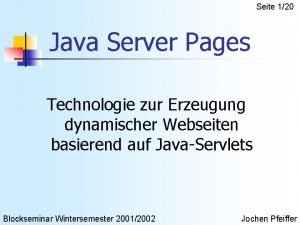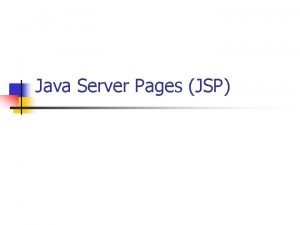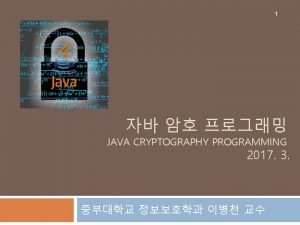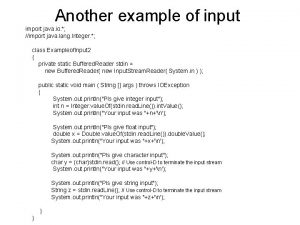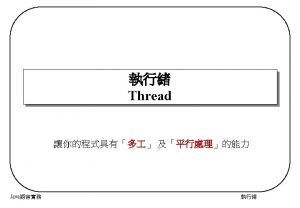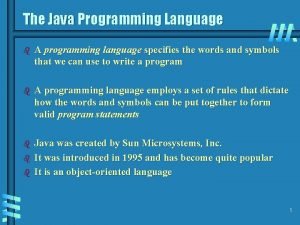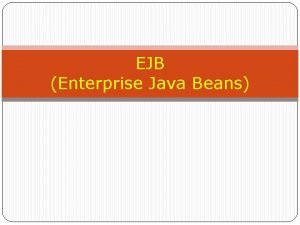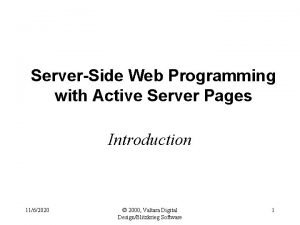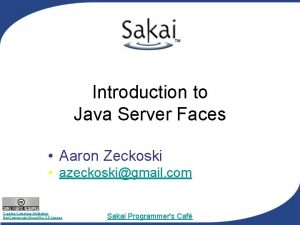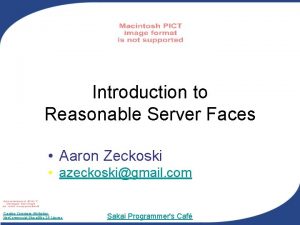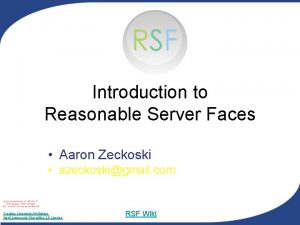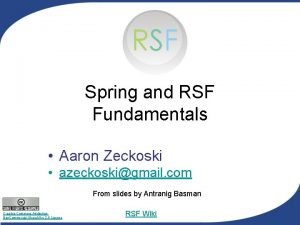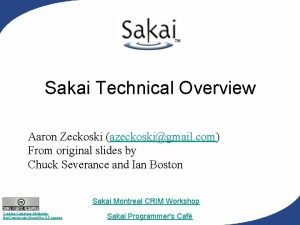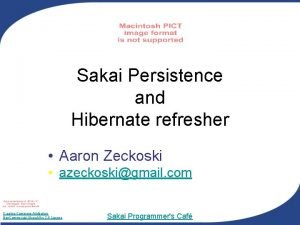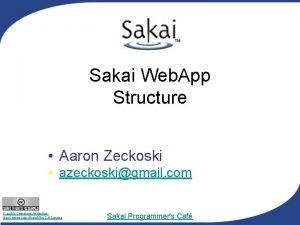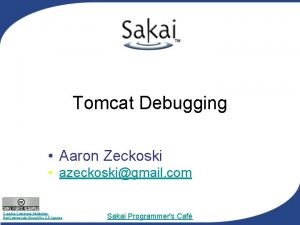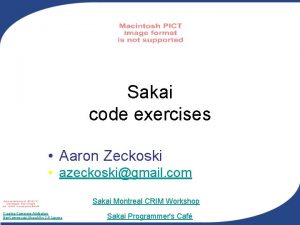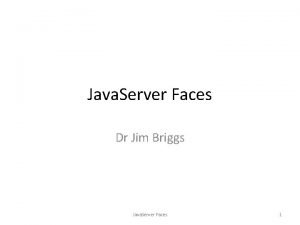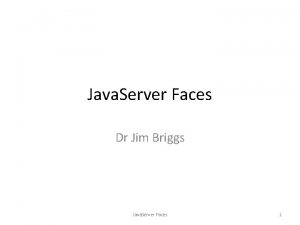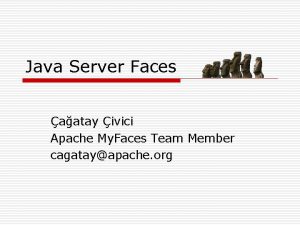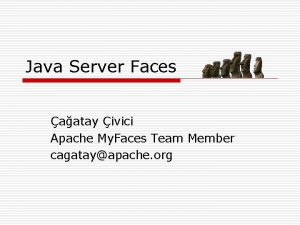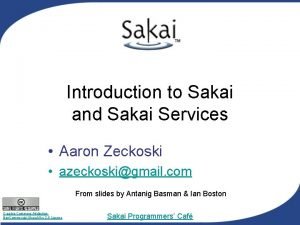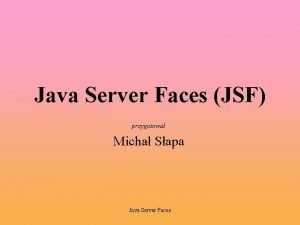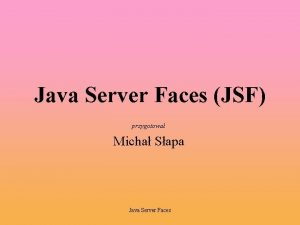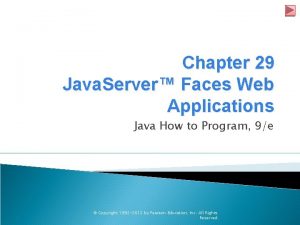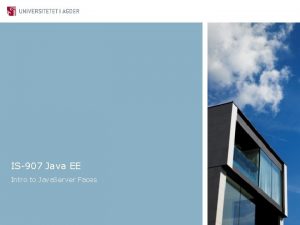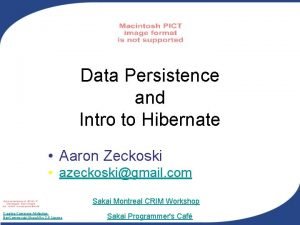Introduction to Java Server Faces Aaron Zeckoski azeckoskigmail



























- Slides: 27

Introduction to Java Server Faces • Aaron Zeckoski • azeckoski@gmail. com Creative Commons Attribution. Non. Commercial-Share. Alike 2. 5 License Sakai Programmer's Café

Java Server Faces • A Java web application framework – Includes the following • A set of UI components (represent html entities) • APIs to represent components, manage state, handle events, validate input, etc. • Custom tag libraries to put JSF in a JSP • State management and even model • Io. C Backing Beans (managed beans) • Expression Language (EL) • Servlet based, normally uses JSPs URL: http: //en. wikipedia. org/wiki/Java. Server_Faces 2

Theory vs. Practice 3

In theory • Web applications that work more like desktop apps – Easier to program – Less concern about request cycle • Better scoping and separation – Application/Session/Request • Component bindings from UI to model • Abstract component tree that is independent of the target (HTML, etc. ) • Good separation of the logic and presentation 4

In practice • Harder to work with than the average web application framework – Big learning curve – Have to understand the request cycle well • Especially the ways JSF may short circuit it • Prevents you from accessing half the capability of HTML – Abstraction done via custom taglibs which make the templates into “JSF XML” – Logic in template and custom tags defeat the goal of separation of UI and logic • JSF event-model introduces the need for wrappers to actually deal with model – Must keep the component tree and event-model in session 5

JSF structure and code 6

JSF structure • The template (most commonly jsp) defines the interface • The faces-config defines the navigation and the backing beans • Backing beans handle action processing, navigation processing, and connections to the logic (business) layer • Wrapper bean wraps the data POJOs for JSF handling • Logic layer beans can be injected as defined in the faces-config • Model is basic data POJO Template (jsp) faces-config (xml) Backing Bean (java) Wrapper (java) Logic Layer (rest of app) model (java) 7

JSF templates • JSP files most of the time • Heavily reliant on tag libraries (taglibs) – Core (f) - basic page definition tags – Html (h) - defines standard html tags • Must learn a large set of restrictive taglibs – Difficult to work with since it does not look like normal html – Even more difficult to write new ones • Large use of EL (expression language) • Can encourage mixing code with html 8

Sample template <%@ taglib uri="http: //java. sun. com/jsf/core" prefix="f"%> <%@ taglib uri="http: //java. sun. com/jsf/html" prefix="h"%> <f: view> <html><head><title>Items</title></head><body> <h: form id="items"> <h: data. Table id="itemlist” value="#{Jsf. Bean. all. Items}” var="entry"> <h: column> <f: facet name="header"> <h: output. Text value=""/> </f: facet> <h: select. Boolean. Checkbox id="item. Select" value="#{entry. selected}" rendered="#{entry. can. Delete}"/> <h: output. Text value="" rendered="#{not entry. can. Delete}"/> </h: column> </h: form> </body></html> </f: view> 9

faces-config. xml • Defines the backing beans – Syntax not like Spring (unfortunately) – Name used in EL in template – Scope controlled (request, session, etc. ) • Defines navigation rules – Based on views • Where from (view) • Which outcome (id) • Where to go (view) – Can match outcomes using wildcards 10

Sample faces-config <faces-config> <navigation-rule> <from-view-id>/jsf/Jsf. Items. jsp</from-view-id> <navigation-case> <from-outcome>new. Item</from-outcome> <to-view-id>/jsf/Jsf. Add. Item. jsp</to-view-id> </navigation-case> <from-outcome>*</from-outcome> <to-view-id>/jsf/Jsf. Items. jsp</to-view-id> </navigation-case> </navigation-rule> <managed-bean-name>Jsf. Bean</managed-bean-name> <managed-bean-class>org. example. jsf. Jsf. Bean</managed-bean-class> <managed-bean-scope>session</managed-bean-scope> <managed-property> <property-name>logic</property-name> <value>#{some. Logic. Bean}</value> </managed-property> </managed-bean> </faces-config> 11

JSF backing beans • Typical bean with getters and setters and additional methods to handle actions – Store data needed for processing the user actions using setters – Retrieve data using getters and methods – Process actions using methods • Often includes code to wrap data objects • Connects to the rest of the application – Typically via injection • Non-recursive (i. e. not like Spring), will not instantiate dependencies of dependencies 12

Sample backing bean public class Jsf. Bean { private Data. Model items. Model; private Jsf. Item. Wrapper current. Item = null; . . . private Jsf. Logic logic; public void set. Logic(Jsf. Logic logic) { this. logic = logic; }. . . public Data. Model get. All. Items() { List wrapped. Items = new Array. List(); List items = logic. get. All. Visible. Items(logic. get. Current. Site. Id()); for (Iterator iter = items. iterator(); iter. has. Next(); ) { Jsf. Item. Wrapper wrapper = new Jsf. Item. Wrapper((Item) iter. next()); wrapped. Items. add(wrapper); } items. Model = new List. Data. Model(wrapped. Items); return items. Model; }. . . public String process. Action. List() { return "list. Items"; } } 13

JSF wrapper bean • Wraps basic data POJO • Required to avoid putting UI information in the data POJO • Often includes basic setters and getters for the UI related properties – Can be methods as well • Also includes a setter and getter for the data POJO 14

Sample wrapper bean public class Jsf. Item. Wrapper { private Item item; private boolean is. Selected; // is this item selected by the user public Jsf. Item. Wrapper(Item item) { this. item = item; } public Item get. Item() { return item; } public void set. Item(Item item) { this. item = item; } public boolean is. Selected() { return is. Selected; } public void set. Selected(boolean is. Selected) { this. Selected = is. Selected; } } 15

Web app basics • 4 key things you need to do in a webapp 1. Output dynamic text • Render data to the screen 2. Loop structures • Output collection or render tables 3. Optional rendering of components • Render some components based on state 4. Trigger Actions • User actions or data transmission 16

Output dynamic text <h: output. Text value="#{Jsf. App. Bean. current. Item. title}"/> <h: output. Text value="#{msgs. jsfapp_text}"/> • Uses the h: output. Text tag – Also h: output. Label and h: output. Format • Uses Expression Language – Requires a bean • Defined in the faces-config or the template • Can set style and turn on/off escaping 17

Loop structure <h: data. Table id="itemlist” value="#{Jsf. App. Bean. all. Items}” var="entry"> <h: column> <f: facet name="header"> <h: output. Text value="#{msgs. jsfapp_text}"/> </f: facet> <h: output. Text value="#{entry. item. title}"/> </h: column> <f: facet name="header"> <h: output. Text value="#{msgs. jsfapp_hidden}"/> </f: facet> <h: select. Boolean. Checkbox id="item. Hidden" value="#{entry. item. hidden}" disabled="true" /> </h: column> </h: data. Table> • h: data. Table is the main loop structure – Also h: panel. Grid to a degree • Takes a collection as value – Uses a variable (entry) to interact with collection • Uses h: column to define each column 18

Optional rendering <h: output. Text value="#{entry. item. title}" rendered="#{not entry. can. Delete}"/> <h: command. Link id="updatelink" action="#{Jsf. App. Bean. process. Action. Update}" rendered="#{entry. can. Delete}"> <h: output. Text value="#{entry. item. title}"/> </h: command. Link> • Handled per h: tag with the rendered attribute (which takes EL) – Can prefix with not to invert • Brings render logic into the template 19

Trigger actions <h: command. Button value="#{msgs. jsfapp_new}" action="#{Jsf. App. Bean. process. Action. New}" /> public String process. Action. New() { current. Item = null; item. Text = TEXT_DEFAULT; item. Hidden = HIDDEN_DEFAULT; return "new. Item"; } • Effectively binds a bean action to a submit button (h: command. Button) – Also h: command. Link • Triggers an action in the bean which returns a string to indicates the view to navigate to 20

JSF in practice 21

JSF experience • JSF has a steep learning curve – Tends to do things in a non-intuitive way • UI components are restrictive – Not enough of them, not flexible enough • Very hard to make AJAX work – This may be changing • Uses Javascript too heavily – URL location is wrong, no back button • Very hard for UI designers to work with 22

JSF structure revisit • The template mixes html and presentation logic Template (jsp) – Bad for UI designers • The faces-config is difficult to maintain (navigation also in the backing bean) faces-config (xml) – Easy to get out of sync – Syntax not like Spring • Backing beans actually work fairly well – One of the saving graces Backing Bean (java) Wrapper (java) • Wrapper bean is extra work to have to deal with – Sometimes have to wrap multiple objects – Requires extra code in the backing bean Logic Layer (rest of app) model (java) 23

Apache My. Faces • Apache implementation of JSF – http: //myfaces. apache. org/ – Open source – Better than Sun reference implementation • Extra features – Additional and more flexible taglibs • Tomahawk (h) - new and updated components – http: //myfaces. apache. org/tomahawk/ • Recommended over the Sun RI URL: http: //myfaces. apache. org/tomahawk/ 24

Oracle ADF faces • A robust and rich set of UI components that work with JSF – Advanced tables – Date and color pickers – File upload – Client side validators • Designed to work with Oracle Jdeveloper • Decent AJAX support URL: http: //www. oracle. com/technology/products/jdev/htdocs/partners/addins/exchange/jsf/ 25

Other faces • Facelets – https: //facelets. dev. java. net/ – JSF without JSP (similar to tapestry) • Struts Shale – http: //shale. apache. org/ – Framework based on JSF, similar to struts 26

Questions? • Java Server Faces Home – http: //java. sun. com/javaee/javaserverfaces/ • My. Faces – http: //myfaces. apache. org/ 27
 6 oblong faces
6 oblong faces Server faces
Server faces Java server pages tutorial
Java server pages tutorial Java telegram bot
Java telegram bot Java irc
Java irc Java client server tutorial
Java client server tutorial Java.rmi.server.codebase
Java.rmi.server.codebase Lập trình socket giao tiếp tcp client/server java
Lập trình socket giao tiếp tcp client/server java Knock knock server java
Knock knock server java Jsf sample
Jsf sample Java server pages
Java server pages Java server pages
Java server pages Jsp o que é
Jsp o que é Java number
Java number Import java.util.*
Import java.util.* Java applet swing
Java applet swing Import.java.util.scanner
Import.java.util.scanner Import java.io.* import java.util.*
Import java.io.* import java.util.* Java gcd
Java gcd Import java.util.random;
Import java.util.random; Import java.io.* in java
Import java.io.* in java Import java.util.
Import java.util. Java import java.io.*
Java import java.io.* Perbedaan java swing dan awt
Perbedaan java swing dan awt Import java.awt.event.*
Import java.awt.event.* Language
Language Ejb remote vs local
Ejb remote vs local Introduction to server side programming
Introduction to server side programming


